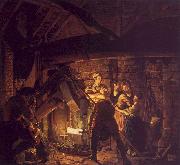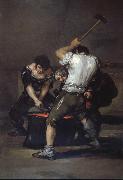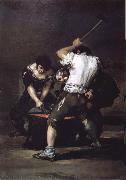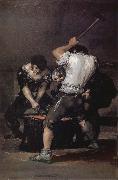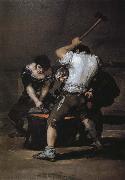
|
Joseph Wright
|
|||
|
|
|||
| 1734-1797 British Joseph Wright Gallery English painter. He painted portraits, landscapes and subjects from literature, but his most original and enduringly celebrated works are a few which reflect the philosophical and technological preoccupations of the later 18th century and are characterized by striking effects of artificial light. He was the first major English painter to work outside the capital all his life: apart from spells in Liverpool (1768-71), Italy (1773-5) and Bath (1775-7), he lived and worked in his native Derby, though exhibiting in London at both the Society of Artists (1765-76, 1791) and the Royal Academy (1778-82, 1789-90, 1794 | |||
|
|
|||
|
The Forge Joseph Wright1.jpg Painting ID:: 663 |
1772 | ||
|
|
|||
|
Francisco Goya
|
|||
|
|
|||
| 1746-1828 Goya is considered the 18th Century's foremost painter and etcher of Spanish culture, known for his realistic scenes of battles, bullfights and human corruption. Goya lived during a time of upheaval in Spain that included war with France, the Inquisition, the rule of Napoleon's brother, Joseph, as the King of Spain and, finally, the reign of the Spanish King Ferdinand VII. Experts proclaim these events -- and Goya's deafness as a result of an illness in 1793 -- as central to understanding Goya's work, which frequently depicts human misery in a satiric and sometimes nightmarish fashion. From the 1770s he was a royal court painter for Charles III and Charles IV, and when Bonaparte took the throne in 1809, Goya swore fealty to the new king. When the crown was restored to Spain's Ferdinand VII (1814), Goya, in spite of his earlier allegiance to the French king, was reinstated as royal painter. After 1824 he lived in self-imposed exile in Bordeaux until his death, reportedly because of political differences with Ferdinand. Over his long career he created hundreds of paintings, etchings, and lithographs, among them Maya Clothed and Maya Nude (1798-1800); Caprichos (1799-82); The Second of May 1808 and The Third of May 1808 (1814); Disasters of War (1810-20); and The Black Paintings (1820-23). | |||
|
|
|||
|
The Forge new4/Francisco Goya-799756.jpg Painting ID:: 31827 |
mk76 Painted between c.1815 and 1820 Oil on canvas 71 1/2x49 1/4in | ||
|
|
|||
|
Francisco Goya
|
|||
|
|
|||
| 1746-1828 Goya is considered the 18th Century's foremost painter and etcher of Spanish culture, known for his realistic scenes of battles, bullfights and human corruption. Goya lived during a time of upheaval in Spain that included war with France, the Inquisition, the rule of Napoleon's brother, Joseph, as the King of Spain and, finally, the reign of the Spanish King Ferdinand VII. Experts proclaim these events -- and Goya's deafness as a result of an illness in 1793 -- as central to understanding Goya's work, which frequently depicts human misery in a satiric and sometimes nightmarish fashion. From the 1770s he was a royal court painter for Charles III and Charles IV, and when Bonaparte took the throne in 1809, Goya swore fealty to the new king. When the crown was restored to Spain's Ferdinand VII (1814), Goya, in spite of his earlier allegiance to the French king, was reinstated as royal painter. After 1824 he lived in self-imposed exile in Bordeaux until his death, reportedly because of political differences with Ferdinand. Over his long career he created hundreds of paintings, etchings, and lithographs, among them Maya Clothed and Maya Nude (1798-1800); Caprichos (1799-82); The Second of May 1808 and The Third of May 1808 (1814); Disasters of War (1810-20); and The Black Paintings (1820-23). | |||
|
|
|||
|
The Forge new11/Francisco Goya-422547.jpg Painting ID:: 38166 |
mk29 c.1815-20 Oil on canvas 181.6x125.1cm | ||
|
|
|||
|
Francisco Goya
|
|||
|
|
|||
| 1746-1828 Goya is considered the 18th Century's foremost painter and etcher of Spanish culture, known for his realistic scenes of battles, bullfights and human corruption. Goya lived during a time of upheaval in Spain that included war with France, the Inquisition, the rule of Napoleon's brother, Joseph, as the King of Spain and, finally, the reign of the Spanish King Ferdinand VII. Experts proclaim these events -- and Goya's deafness as a result of an illness in 1793 -- as central to understanding Goya's work, which frequently depicts human misery in a satiric and sometimes nightmarish fashion. From the 1770s he was a royal court painter for Charles III and Charles IV, and when Bonaparte took the throne in 1809, Goya swore fealty to the new king. When the crown was restored to Spain's Ferdinand VII (1814), Goya, in spite of his earlier allegiance to the French king, was reinstated as royal painter. After 1824 he lived in self-imposed exile in Bordeaux until his death, reportedly because of political differences with Ferdinand. Over his long career he created hundreds of paintings, etchings, and lithographs, among them Maya Clothed and Maya Nude (1798-1800); Caprichos (1799-82); The Second of May 1808 and The Third of May 1808 (1814); Disasters of War (1810-20); and The Black Paintings (1820-23). | |||
|
|
|||
|
The Forge new11/Francisco Goya-878744.jpg Painting ID:: 38295 |
mk132 1812-16 Oil on canvas 181.6x125cm | ||
|
|
|||
|
Francisco Goya
|
|||
|
|
|||
| 1746-1828 Goya is considered the 18th Century's foremost painter and etcher of Spanish culture, known for his realistic scenes of battles, bullfights and human corruption. Goya lived during a time of upheaval in Spain that included war with France, the Inquisition, the rule of Napoleon's brother, Joseph, as the King of Spain and, finally, the reign of the Spanish King Ferdinand VII. Experts proclaim these events -- and Goya's deafness as a result of an illness in 1793 -- as central to understanding Goya's work, which frequently depicts human misery in a satiric and sometimes nightmarish fashion. From the 1770s he was a royal court painter for Charles III and Charles IV, and when Bonaparte took the throne in 1809, Goya swore fealty to the new king. When the crown was restored to Spain's Ferdinand VII (1814), Goya, in spite of his earlier allegiance to the French king, was reinstated as royal painter. After 1824 he lived in self-imposed exile in Bordeaux until his death, reportedly because of political differences with Ferdinand. Over his long career he created hundreds of paintings, etchings, and lithographs, among them Maya Clothed and Maya Nude (1798-1800); Caprichos (1799-82); The Second of May 1808 and The Third of May 1808 (1814); Disasters of War (1810-20); and The Black Paintings (1820-23). | |||
|
|
|||
|
The Forge new18/Francisco Goya-272823.jpg Painting ID:: 50767 |
mk214 c.1817 Oil on canvas 181.6x125cm | ||
|
|
|||
|
Also Buy::. For Following Paintings / Artists / Products, Please Use Our Search Online: |






